Best Podcast Equipment & Setup for 2024
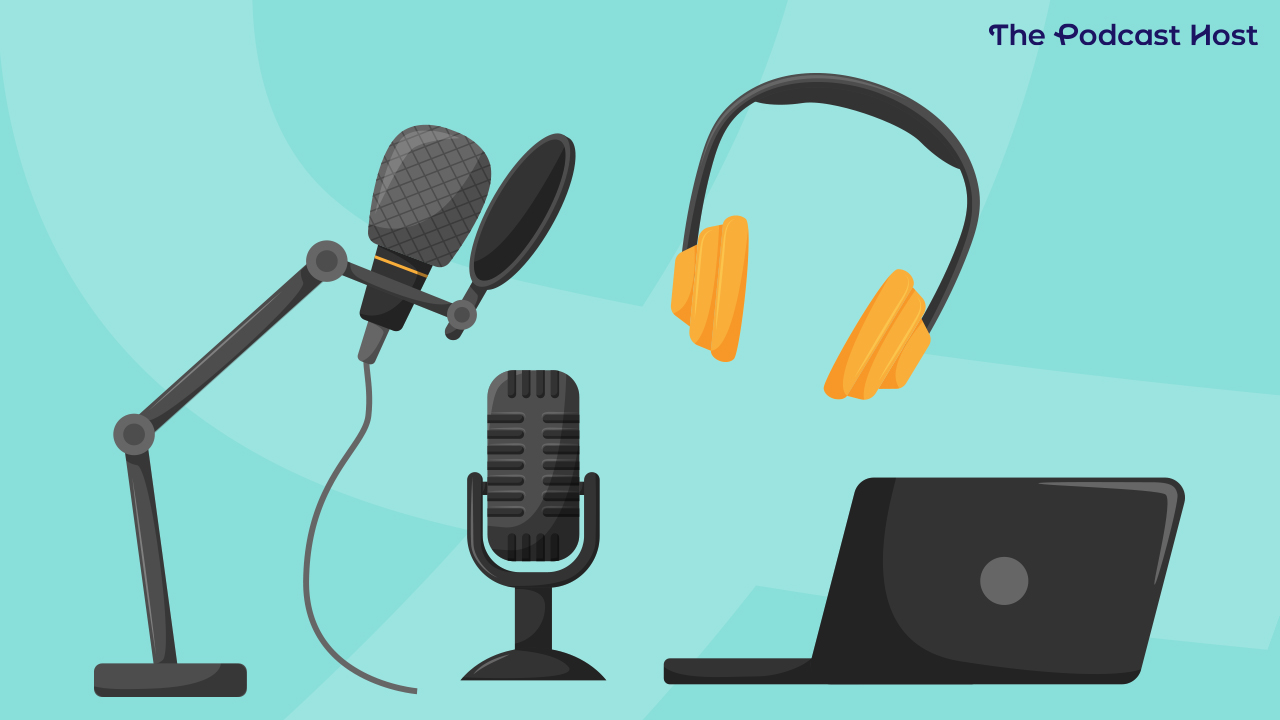
Podcast equipment and setup: These terms cover a wide variety of gear and the other bits and pieces needed to make a room sound good. It’s easy to imagine a pro-level radio studio filled with lots of intimidating (and very expensive) equipment. But for most creators, that looks nothing like their own podcast setup.
“Choose your tools carefully, but not so carefully that you get uptight or spend more time at the stationery store than at your writing table.”
Natalie Goldberg.
You can break podcast equipment into categories based on how you record and capture your voice, from mic to mixer to recorder to computer.
The recording process can be as straightforward or as complicated as you like. You can record right into your computer without any mixers or recorders. Or you can go the full studio route.
If you use minimal kit, the process will be simple, but you’ll also have less flexibility and control. This isn’t an issue for most aspiring podcasters, though, as they’ve no intention of becoming an audio engineer – they just want to get their message out there.
If you fall into that bracket, this podcast equipment and setup guide is for you. Here, we’ll look at what you might need and why you might need it when you’re planning to start your first podcast…
If you need to zoom out first, see everything you need to record a podcast, from planning to software.
Types of Podcast Equipment (And Why Podcasters Might Need Them)
Let’s run through the various pieces of equipment commonly used to record a podcast, then. We’ll start with the microphone, then look at things like recorders, USB interfaces, and even headphones. Let’s dive in…
The Microphone: Podcast Equipment & Setup
You might imagine the typical musician’s mic when you think about a microphone. And, whilst you can absolutely use one of these to podcast, it’s worth noting that mics come in many forms, shapes, and sizes.
The bottom line is that a microphone is simply the tech needed to “hear” your voice and send it to be recorded somewhere. This makes it the first part of our recording “chain.”
So what options are available to us when thinking about our microphone?
Here are the main types, with links to our guides. Or, read on to get a summary.
- Read More: Best Podcast Microphones of every kind
- Read More: Best USB Microphones for Podcasting
- Read More: Best Headset Microphones
USB Microphone
A common and simple piece of podcast equipment is the USB microphone. Often these are condenser mics (as opposed to dynamic microphones), which plug straight into your computer via – oddly enough – a USB cable. USB mics are ideal for beginners, especially folks who do solo/monologue-style shows, and those running online interview podcasts. Almost all of these mics have a Cardioid polar pattern, which means they are designed to pick up the voice of one single speaker at a time.
Check out our USB mics roundup to look through our favourite options.
XLR Microphone
XLR mics need additional equipment to run them. They don’t plug straight into your computer but instead go into an interface, preamp, mixer, or digital recorder (more on these all later).
You can actually get interfaces, mixers, and digital recorders in USB form, though. So you can run an XLR mic into your computer, just not directly.
XLR mics are suited to folks who want premium audio quality and a lot more production flexibility, as well as those who don’t want to be tied to a computer at all times. Check out the best podcasting mics roundup for our top picks there.
It’s a good idea to look for microphones with a shock mount and a built-in pop filter. Or, you might think about tagging a stand-alone double-layer pop filter onto your purchase. These two tools are precious for podcasters working at the same desk they’re recording from and will help eliminate unwanted noise.
Condenser or Dynamic Microphones: Best Quality?
Whilst XLR and USB tell us how the mic is connected (and what it’s connected to), the terms “condenser” and “dynamic” tell us how the mic is built and how it functions. XLR and USB mics can be either dynamic or condenser, though it’s common for USB mics to fall into the latter category.
We have an in-depth breakdown of the difference between dynamic and condenser mics, but the succinct (and highly simplified) version is this:
Dynamic – more robust, more forgiving of sub-optimal environments.
Condenser – more nuanced for vocal recordings.
There’s no “best” answer here. Only what works best for you.
Wireless & Lavalier Mics
Not every podcaster records at a computer or standing at a mic stand in a studio. There are situations where some creators need a little more flexibility. Take someone who does a Yoga series, for example. They’re going to be in all sorts of dynamic poses during a recording session.
Then, there are podcasters who record on the go, wherever they can. These creators need podcast equipment that’s quick, flexible, and portable. That’s where lavalier and wireless mics come in.
Lavalier (or ‘lav’) mics are typically seen on TV – think of the wee cable pinned to the chest of a newsreader. A popular example of a lav mic in podcasting is the Rode SmartLav +, which we’ll mention again shortly.
There’s also an ever-growing range of wireless options in the podcast equipment domain these days. This type of kit can be lavalier-style, but it doesn’t have to be. The Rode Wireless Pro, for example, lets you connect lav mics to the transmitters, but you can directly record into those, too.
The Rode Wireless Pro is the Gold Standard of wireless mics in podcasting. It even has a feature known as ‘32-bit floating’ which makes it almost impossible to distort your audio, even if you’re way too loud and your gain is set too high.
A kit like the Rode Wireless Go would be perfect for co-hosts who explore places like ruined buildings or open natural environments. But, there are other options for such portability, too…
Recording Devices That Include Mics
You probably already carry a mic around with you in the form of your smartphone. You can turn this into a podcast setup by adding the Rode SmartLav+ and AI-Micro. This kit is ideal for on-the-go recording and location interviews.
Phones and laptops have built-in mics that some would consider good enough for podcasting. As is commonly the case with audio, the “good enough” part is entirely down to your own opinion.
Alternatively, there are a lot of high-quality digital recorders on the market. You can record directly into these or plug additional mics into them. Again, these are a great option for someone looking for a flexible and portable setup.
The Recorder: Podcast Equipment & Setup
And speaking of digital recorders, we now need a podcast equipment option for actually capturing and storing your audio. This could be anything from a phone, to a computer, to a dedicated digital recorder itself.
Digital Recorders
A dedicated digital recorder is an excellent option for someone who wants to podcast on the go but is looking for a level of sound quality above what you’ll get with a smartphone.
On top of that, digital recorders offer a lot more settings and options for creating audio because that’s what they’re literally built for. You don’t necessarily need an additional mic to record into one because most of them come with built-in mics. Additional benefits include built-in SD card slots and multiple input(s). The SD cards can be handy when you want to quickly drop some audio files over to your desktop and can’t be bothered to relocate and plug in all your equipment.
Computers
There are many options available to you when it comes to recording directly into a computer. You can use a DAW (Digital Audio Workstation) like Audacity or Adobe Audition (check out our comparison of the two!) for starters. Or, if you’re looking to record online/remote interviews, there are plenty call recording options on the market nowadays too. Check out our podcast software guide for more on this front.
You also might want to look at our best computers and best laptops for podcasting if you’re in the market for something optimal.
Smartphones
There are a tonne of recording apps out there that’ll enable you to record directly into your phone. You probably have a default recording app on there already. But here are a few options if you want to upgrade your sound and range of flexibility.
Recording into a phone can be really convenient, though it lacks the flexibility and options of a dedicated digital recorder. Nevertheless, it’s often a great starting point for many, and you can always upgrade your equipment further down the line.
Mixers & Audio Interface Preamps: Podcast Equipment & Setup
You don’t actually need an interface or mixer to podcast, but many podcasters do still utilise them. So why might you consider getting one?
- If you want to use an XLR mic.
- If you want to use multiple mics.
- If you want to record live, or “as live” – with all your music, SFX, etc. played in real-time.
- If you want to incorporate multiple audio sources into your recording.
My favourite interface is a little USB device called the Focusrite Scarlett 2i2, but there are other good USB audio interface options for podcasters on the market, too.
On the mixer front, there’s a growing argument that they’re no longer necessary for podcasters who want all of the features listed above. Podcast-specific devices like the Zoom PodTrak P4 and Rode Rodecaster II are much better options these days, in my opinion. That said, if a mixer is still something you’d like to shop around for, here’s our best podcast mixers roundup, which will give you a few options.
Headphones: Podcast Equipment & Setup
Headphones are a vital part of the podcast equipment lineup.
You should constantly monitor your recordings, even when doing a solo show. This means using a pair of headphones whilst recording so you can hear exactly what’s being captured. The benefit of doing this is that if there are issues, you can fix them right away.
You’ll also need headphones to hear your guest if you run an online interview show. They come in handy for listening back to recordings and for editing audio too. Check out our best podcast headphones roundup for a few great options there.
If you’re recording in person and your audio mixer only has one headphone jack output, you can use a headphone splitter. This means both you and your guests can wear headphones, though you won’t have any individual control over the volume.
Acoustic Treatments
You can have the best podcast equipment and setup in the world, but if you stick it all in a poor-quality room, your show will sound terrible.
Acoustic treatment for reverb in your room is key. We have a full guide to setting up your podcast home studio that includes everything from utilising acoustic blankets to popping your mic into a cat bed or building a “cloffice” space. Of course, you’ll want to eliminate unwanted background noise (ambient noise) as much as possible, too.
Bottom line – if you get your environment on-point, even the most no-frills budget podcast setup can sound top-class. And, there are more premium and expensive options, too, if you don’t want to spend your recording sessions under a duvet. Check out our full guide to tackling reverb for a deeper dive.
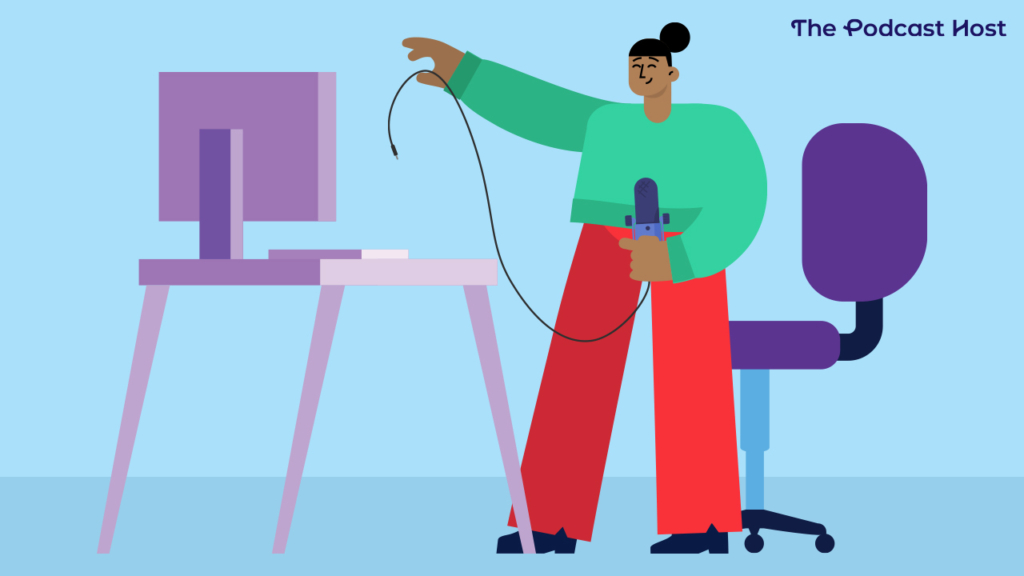
Other Podcasting Gear: From Pop Filters to Boom Arms
Podcasting equipment rarely works in isolation, and you can add a few other pieces to your setup to really enhance your sound.
Even if your mic has a built-in pop filter or windshield, it’s still a good idea to experiment with an external one. This means you can get up close with the mic, giving your voice a more intimate sound, without popping plosives everywhere.
A pop filter will attach to your mic stand or boom arm. These are also good bits of kit to make part of your podcast setup because they help eliminate handling noise.
There’s a whole new world of cables and connectors to explore, too. Though, fear not, you’ll almost always be using XLR or USB!
Podcast equipment will only work as well as you use it, and these additional gizmos can help make your show sound more professional overall.
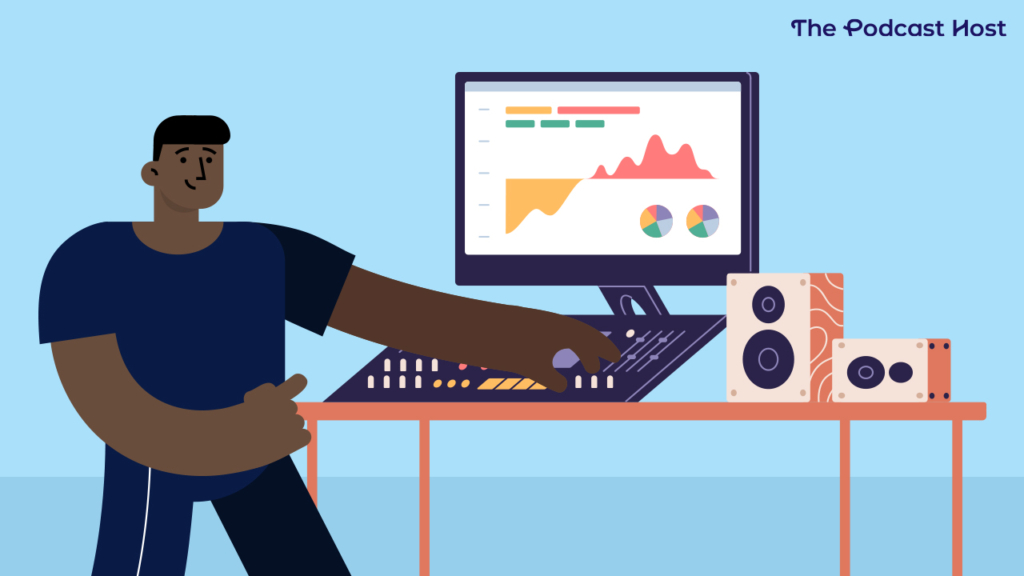
Editing, Audio Production, & Publishing
Once your podcast has been recorded, you will likely want to edit it. How much editing (if any!) you do, is entirely up to you. See how much editing should I do in my podcast? for more on that.
When we get to this stage, the “podcast equipment” side of things is really just as simple as a computer or laptop. It’s what software and tools you use on your machine that you need to give thought to.
Audacity & Adobe Audition
On the editing front, you can choose one of the many software options out there. I’ve mentioned DAWs (Digital Audio Workstations) like Audacity and Adobe Audition; these are both great post-production options.
Both allow you to edit and produce in multi-track. These tracks can be used to move around and position various audio files to build your final episode. You can also save these sessions as projects or templates, too. So you can have your music, transitions, and effects in place for each new episode.
Alitu
If you want to do some editing, as well as add in some intro and outro music, but you don’t want to learn how to use a DAW, then check out Alitu. Alitu is our own “podcast maker” software that makes it easy to record, produce, and publish your podcast, even if you know nothing about audio. Again, you’ll just need a computer to run it.
Alitu has a call recorder built-in, and it’ll do all the levelling, noise reduction, compression, and EQ for you automatically. Alitu even has text-based editing where it auto-generates transcriptions of your episodes, and any text you delete will also remove the corresponding audio!
Finally, you can even host, publish, and distribute your podcast via Alitu’s hosting, which brings us nicely to the next part of the chain…
Podcast Hosting
In order to publish your podcast for the world to hear, you need to sign up for a media hosting provider. This is basically where your podcast lives online, and the hub where places like Apple Podcasts and Spotify will look to pull all your content from.
You’ll find our favourite podcast hosting platforms right here. Each one has its own unique features, and there’s something there to suit any podcaster, no matter their skill level, motivation, or budget.
Podcast Equipment FAQ
We get asked a lot of questions about podcast equipment in our IndiePod Community. Here, we’ll answer some of the most frequent.
What’s the Best Podcast Equipment Setup for Podcast Interviews?
Podcast interviews are done either locally (in person) or remotely. If you’re going remote, your setup can be as simple as a USB mic. You’re essentially recording like a solo podcaster and relying on remote recording software to take care of the tech.
Alternatively, you can use equipment rather than software for remote recordings. Audio mixers are traditional options, whilst there are podcast-specific interfaces these days, such as the Zoom PodTrak P4 or the Rode Rodecaster II.
The PodTrak P4 and Rodecaster work well for in-person recordings, too. They have multiple XLR outputs so that guests can get their own mic. They can also wear headphones with their own individual volume control!
Whether you’re recording remotely or locally, having each guest on their own mic and audio channel will give you better quality audio. This individual control can go a long way to creating consistency and balance and minimising unwanted background noise.
Do I Need Any Gear for Podcast Music?
Not unless you’re a musician planning to make your own, no. Podcast music is typically added in the post-production and editing phase. That said, you can use certain types of equipment to play music and effects “as live” during your recordings. This works particularly well for live broadcasts and saves you from having to edit them in later.
Podcast mixers are great for this purpose, as are pieces of kit like the Zoom PodTrak P4 and Rode Rodecaster II.
Podcast Equipment Choices on Amazon
Amazon has an entire section dedicated to podcast equipment. There are very few bits of kit you can’t pick up on Amazon, and you’ll find many an affordable option on there. Remember, there’s no “one size fits all” podcast equipment option, but the podcast starter kit from Samson is as close as we’ve seen.
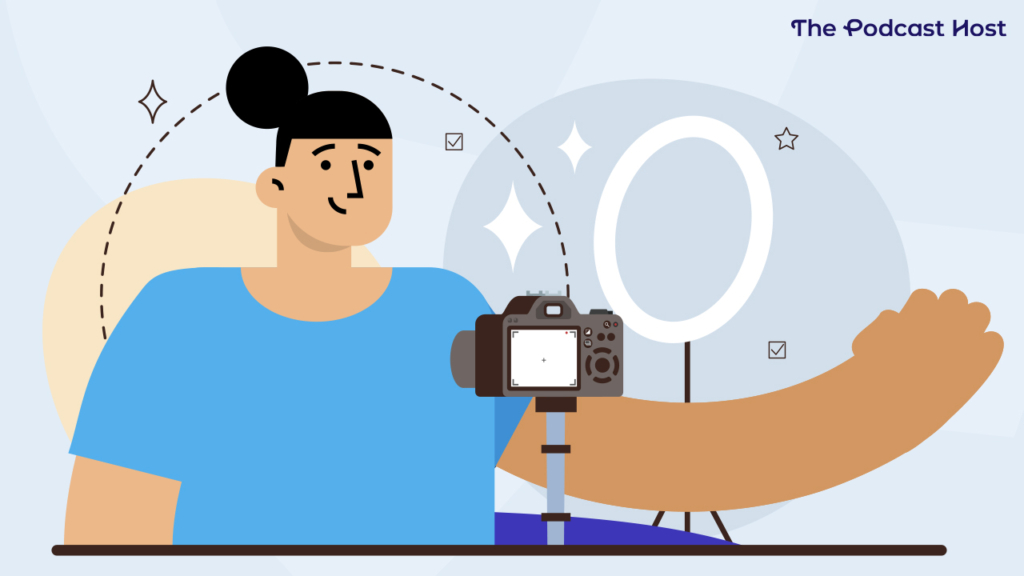
What About Equipment for Video Podcasts?
First up, be wary of anyone telling you that you need to add a video component to your show. Many successful podcasts are 100% audio-only, and many others who run video will tell you that their video views are dwarfed by their audio downloads.
If you do decide that you’d like to publish video as well as audio, then this is going to add a few pieces of kit to your setup. We cover this in full in our dedicated video podcasting guide. But the big three are an HD camera, a tripod, and some lighting. We also have a handy guide to the best video editing software if you’re keen to go down this path.
Podcast Equipment Is a Means to an End
I mentioned already that most people don’t get into podcasting to collect loads of fancy and expensive audio equipment. Some folks do end up doing that, of course, but you definitely don’t need to.
It’s better to start simple so you can focus on your actual content, rather than whether or not your long chain of gear is all working correctly. Over time, as you grow, you can tweak and upgrade things here and there.
Summary: Best Podcast Equipment & Setup for Beginners & Pros Alike
Let’s sum things up by going full if…then. Here’s how you can decide what gear you need:
1. If you’re recording solo, or recording interviews online, then:
Get a Samson Q2U mic
2. If you’re recording two people in person, on a budget, then:
3. If you’re recording two or more people in person, either on the go or in-studio and have the budget for high quality, then:
Get two or more Shure SM58s and the Zoom PodTrak P4
The Samson Q2U is our most recommended mic and suits 90% of new podcasters perfectly. It functions as both a USB and XLR mic, so if you decide to upgrade to a recorder or interface further down the line, it’ll work with them, too. It’s also excellent value, and well within most folks’ budgets. You’ll often find the Q2U available in bundle deals with other podcast equipment, such as a boom arm, pop filter, and headphones. This makes for an ideal podcast starter kit.
Aside from that, it’s hard to make any one-size-fits-all recommendations because there are so many variables. But remember, when it comes to recording, editing and publishing, then be sure to check out our podcast production app Alitu.
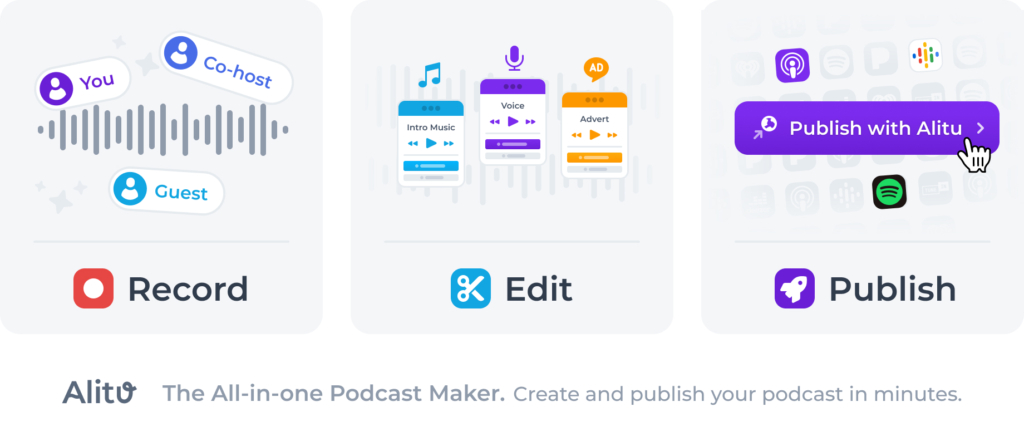
And, if you’re looking for more help or guidance towards any aspect of podcast equipment, then have a look at the IndiePod Community. It truly is the best place to learn, grow and connect on all things independent podcasting.
